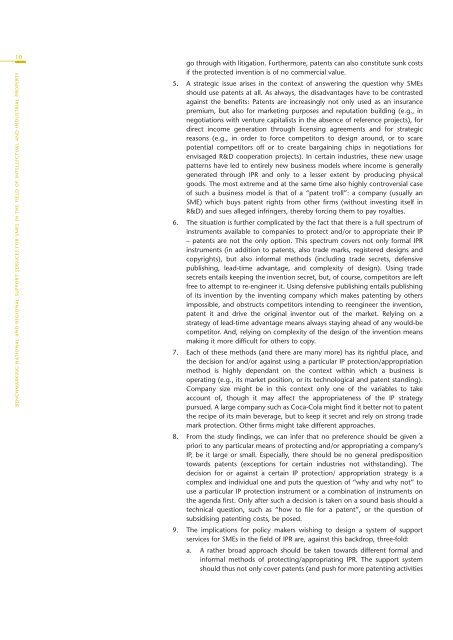Benchmarking National - PRO INNO Europe
Benchmarking National - PRO INNO Europe
Benchmarking National - PRO INNO Europe
You also want an ePaper? Increase the reach of your titles
YUMPU automatically turns print PDFs into web optimized ePapers that Google loves.
10<br />
BENCHMARKING NATIONAL AND REGIONAL SUPPORT SERVICES FOR SMES IN THE FIELD OF INTELLECTUAL AND INDUSTRIAL <strong>PRO</strong>PERTY<br />
go through with litigation. Furthermore, patents can also constitute sunk costs<br />
if the protected invention is of no commercial value.<br />
5. A strategic issue arises in the context of answering the question why SMEs<br />
should use patents at all. As always, the disadvantages have to be contrasted<br />
against the benefits: Patents are increasingly not only used as an insurance<br />
premium, but also for marketing purposes and reputation building (e.g., in<br />
negotiations with venture capitalists in the absence of reference projects), for<br />
direct income generation through licensing agreements and for strategic<br />
reasons (e.g., in order to force competitors to design around, or to scare<br />
potential competitors off or to create bargaining chips in negotiations for<br />
envisaged R&D cooperation projects). In certain industries, these new usage<br />
patterns have led to entirely new business models where income is generally<br />
generated through IPR and only to a lesser extent by producing physical<br />
goods. The most extreme and at the same time also highly controversial case<br />
of such a business model is that of a “patent troll”: a company (usually an<br />
SME) which buys patent rights from other firms (without investing itself in<br />
R&D) and sues alleged infringers, thereby forcing them to pay royalties.<br />
6. The situation is further complicated by the fact that there is a full spectrum of<br />
instruments available to companies to protect and/or to appropriate their IP<br />
– patents are not the only option. This spectrum covers not only formal IPR<br />
instruments (in addition to patents, also trade marks, registered designs and<br />
copyrights), but also informal methods (including trade secrets, defensive<br />
publishing, lead-time advantage, and complexity of design). Using trade<br />
secrets entails keeping the invention secret, but, of course, competitors are left<br />
free to attempt to re-engineer it. Using defensive publishing entails publishing<br />
of its invention by the inventing company which makes patenting by others<br />
impossible, and obstructs competitors intending to reengineer the invention,<br />
patent it and drive the original inventor out of the market. Relying on a<br />
strategy of lead-time advantage means always staying ahead of any would-be<br />
competitor. And, relying on complexity of the design of the invention means<br />
making it more difficult for others to copy.<br />
7. Each of these methods (and there are many more) has its rightful place, and<br />
the decision for and/or against using a particular IP protection/appropriation<br />
method is highly dependant on the context within which a business is<br />
operating (e.g., its market position, or its technological and patent standing).<br />
Company size might be in this context only one of the variables to take<br />
account of, though it may affect the appropriateness of the IP strategy<br />
pursued. A large company such as Coca-Cola might find it better not to patent<br />
the recipe of its main beverage, but to keep it secret and rely on strong trade<br />
mark protection. Other firms might take different approaches.<br />
8. From the study findings, we can infer that no preference should be given a<br />
priori to any particular means of protecting and/or appropriating a company’s<br />
IP, be it large or small. Especially, there should be no general predisposition<br />
towards patents (exceptions for certain industries not withstanding). The<br />
decision for or against a certain IP protection/ appropriation strategy is a<br />
complex and individual one and puts the question of “why and why not” to<br />
use a particular IP protection instrument or a combination of instruments on<br />
the agenda first. Only after such a decision is taken on a sound basis should a<br />
technical question, such as “how to file for a patent”, or the question of<br />
subsidising patenting costs, be posed.<br />
9. The implications for policy makers wishing to design a system of support<br />
services for SMEs in the field of IPR are, against this backdrop, three-fold:<br />
a. A rather broad approach should be taken towards different formal and<br />
informal methods of protecting/appropriating IPR. The support system<br />
should thus not only cover patents (and push for more patenting activities
















